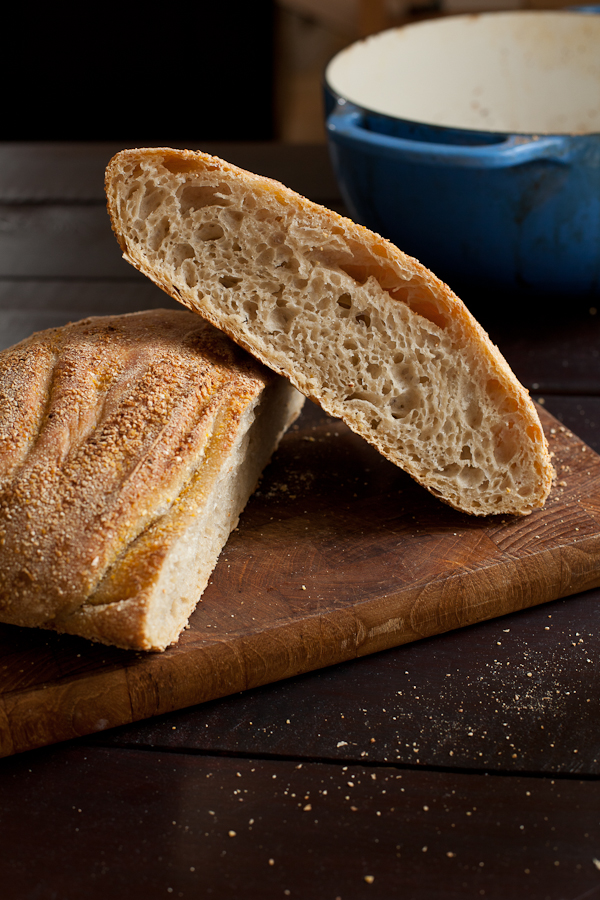Ever since I started making the “five minute a day bread” back in the fall, I’ve been pretty much going through the motions. I tweaked the recipe a bit to a point where I can bake consistent and tasty bread with practically no effort. This is awesome, and has ruined me for most grocery-store-bakery breads and the idea of buying sliced bread in a plastic bag seems completely foreign to me. However, while this bread is convenient, tasty, and relatively healthy it does get a little boring. I don’t generally have time to try super long and/or complicated recipes, but since Dr. Fiance is away at a conference and I’m on my own this week I decided to take a shot at the low yeast, long fermentation, baked in a dutch oven method.
I could go into a long description of the method, theory and recipe but luckily for me Bittman has already done all of that. Check out the column in the New York times which will give you all of the particulars. The essentials of the method are as follows: a small amount yeast, a wet dough, and a long fermentation period prior to baking in an covered dutch oven. Instead of trying to rewrite that article I’m going to pass along a couple of notes on my first attempt which may come in handy.
First, I have active dry yeast rather than the called for instant yeast. So rather than mixing the yeast with the dried ingredients I dissolved it in the water before I mixed up the dough for fermentation. This may or may not have an effect on how much my dough rose. More importantly, I think I added too much water in the first place. The recipe calls for two cups, and it’s possible I added a little more than that through sloppy measurement practices. The result is that my dough was soupy rather than shaggy, as the recipe suggested.
This meant that after the fermentation, when I went to form it into a ball, the dough slid into more of a pancake. And the results were a very lovely tasting loaf shaped more like a flying saucer than a boule. I think that my yeast was fine, it was just that the dough was too wet to hold the required surface tension. As it is, there is only a scant half teaspoon of yeast for this recipe, which is a tiny amount compared to my every day bread. This recipe has four cups of flour for that half teaspoon, while my six cup batch of everyday bread takes one and a half tablespoons of yeast.
Which is better, fast method or slow method? To be fair, the flavor in the dutch oven bread is much richer than the everyday bread, but it did take 18 hours to ferment, followed by a couple of hours of additional rising. It is fussy. It doesn’t take a lot of skill or actual time, but you do kinda have to be around to take care of it to hit those time points. The good thing is that the crust is outstanding – crispy, thick, chewy, everything I would want good peasant bread crust to be. I think I could have even baked it longer and gone darker and crisper than I did. The crumb really is custardy and moist with beautiful air holes, which again, is everything I want from a crusty peasant bread.
Given the flatness and the super-wetness of the dough, I will definitely try it again to try to improve using less water. However, this recipe does make a huge loaf, and since I’m by myself this week and I’m not chopping down trees or running a marathon I’ll be good on bread for a few days.






4 Comments
I’m Back with Baguettes « Shoot to Cook
October 19, 2011 at 2:41 pm[…] minute artisan bread dough in the fridge and made a loaf nearly every day. Then I moved on to the Peter Reinhart dutch oven bread which was more time consuming but had a much better flavor. In between I’d made sandwich […]
Jim Lahey Slow Fermentation Pizza Dough « Shoot to Cook
March 5, 2012 at 10:10 am[…] As you may recall, Lahey is the guy who came up with the method for one of my favorite breads: Dutch Oven No-Knead Bread which is insanely delicious, easy to make, and is always an impressive crowd pleaser when […]
chuck b
May 19, 2012 at 12:39 pmI make dutch oven bread, a lot. The NYT article doesn’t actually give you the recipe, in fact, it is inaccurate to a point of pointing a novice in the wrong direction. The % of moisture they state is incorrect. In any event, the recipe for a higher rise while maintaining the crust and texture is as follows:
4 cups bread flour
1.75 cups total liquid (I use an ounce of honey)
1/4-3/8 tsp dry yeast, mixed in the honey water.
2 tsp kosher flake salt, crushed (3 tsp for rye)
mix, let sit for 12 -18 hours. More yeast (1/2 tsp) and a warm oven (with light on) allows for a nice 12 hour bread, better on our schedules.
AFTER the RISE:
Start to oven preheating WITH the crock to 500. While that’s going on, quickly and gently, roll the dough out of the bowl onto a piece of parchment paper, lightly dusted. Very gently (want to keep the air) flour it so no sticky parts are exposed while you slightly shape the loaf. Score (help blooming) and cover for about 10- 15 minutes, or whatever time it takes the oven to heat. Turn the oven down to 450, and put a cookie sheet UNDERNEATH the crock to prevent added heat from over cooking the bottom. Open the oven and put in the loaf WITH the parchment paper. By picking up the loaf with parchment paper, you avoid over-handling and mistakenly pushing air out and avoid having the “drop” the loaf, but rather, placing it into the dutch oven. Cover, immediately.
Bake covered for 35 minutes, then uncovered for 10 more, and then about 3-4 minutes out of the crock on the rack inside the oven.
Cool and eat.
For RYE bread, use the same recipe, but replace 2 cups of bread flour with light rye and add 3 TBSP of caraway seeds and 3 tsp salt. Sometimes, I add about 1 TBSP of canola oil to the rye.
Good Luck!
ShootToCook
May 20, 2012 at 10:01 amThanks for the advice Chuck, I’ll check out your recipe and method and see if it works better for me. The parchment paper idea sounds great and much easier than flipping it into the pan from a towel.